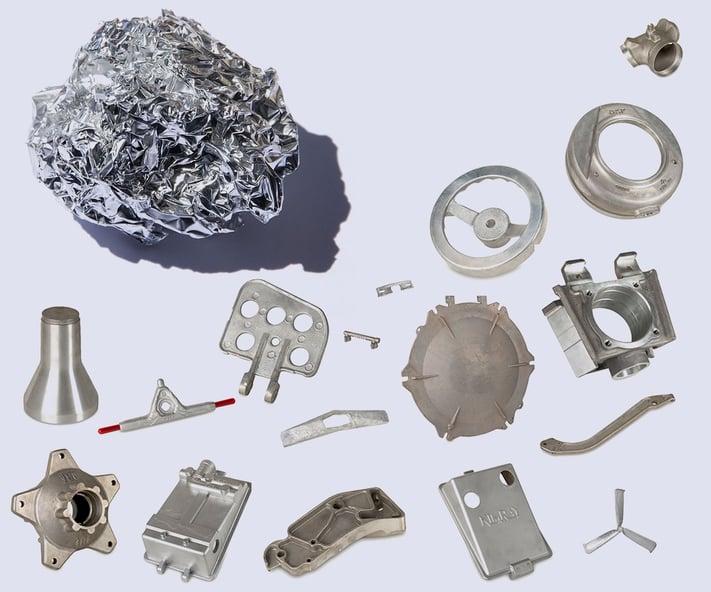Excitement About Aluminum Castings Company
Aluminum Castings Company for Dummies
Table of ContentsThe Greatest Guide To Aluminum Castings CompanyThe Ultimate Guide To Aluminum Castings CompanyA Biased View of Aluminum Castings CompanyA Biased View of Aluminum Castings CompanyAluminum Castings Company for BeginnersThe smart Trick of Aluminum Castings Company That Nobody is DiscussingSee This Report on Aluminum Castings CompanyThe Greatest Guide To Aluminum Castings Company
There are 2 primary kinds of die casting utilized in the aluminum spreading sector: hot chamber pass away spreading and chilly chamber pass away spreading. The primary distinction between these approaches is how the molten metal is delivered to the mold and mildew. In warm chamber pass away casting, frequently made use of for reduced melting factor steels, the fusion is straight linked to the equipment, and a bettor requires the material with a gooseneck right into the die cavity.
Aluminum Castings Company Can Be Fun For Everyone
In these techniques, the mold is intentionally ruined or damaged away in order to extract the ended up aluminum spreading. Usual procedures under the classification of expendable mold and mildew spreading include (financial investment casting),,, and financial investment casting. When manufacturing custom-made aluminum parts using expendable molds, suppliers put molten aluminum or light weight aluminum alloys into the mold and mildew, which is after that broken apart to release the strengthened metal component.
The is one of the oldest and most utilized kinds of aluminum casting. It involves condensing specialized shop sand, commonly reinforced with clay or resin, around a precisely crafted multiple-use pattern that figures out the shape and inner information of the finished aluminum product. The pattern system includes risers and vents to handle the flow of liquified steel and to avoid casting flaws such as contraction porosity.
The Best Guide To Aluminum Castings Company

This mold is then preheated before the putting of molten light weight aluminum or light weight aluminum alloy. As the metal fills the covering, it catches the detailed details and great surface coating of the mold. Once cooled, the ceramic is mechanically or chemically damaged away, permitting the removal and separation of specific actors parts.
About Aluminum Castings Company
Permanent mold spreading utilizes multiple-use steel mold and mildews and is optimal for automation with regular high quality and less waste. Expendable mold and mildew casting makes use of single-use molds, like sand or foam, supplying layout flexibility and reduced tooling costs for models or brief runs. Pass away spreading is best for creating high quantities of aluminum components that require tight tolerances, great information, and smooth surfaces.
The Carat includes innovative control systems for accurate process administration, including automatic ladling, real-time high quality control, and energy-efficient operation. The Toshiba Device DC-J Series includes pass away casting devices appropriate for light weight aluminum. Recognized for their robust building and construction and check here high injection performance, these equipments ensure efficient and exact casting. They feature sophisticated hydraulic and control systems for constant high quality, in addition to real-time tracking, automatic lubrication, and user-friendly programming interfaces.

While aluminum can be used in its pure form, it is frequently alloyed with other steels to improve its homes or the residential or commercial properties of the various other metals. Light weight aluminum alloys are categorized into eight collection, numbered from one to eight.
Aluminum Castings Company for Dummies
This alloying boosts the stamina and solidity of light weight aluminum but reduces its ductility and rust resistance. The 2000 collection alloys are testing to weld yet can be warm treated to improve their properties. The 3000 series alloys are primarily alloyed with manganese. This mix improves corrosion resistance while offering modest strength.
The 4000 series alloys are alloyed with silicon, which lowers the melting point and boosts fluidity. This makes it a prominent selection for spreading, as it is easy to develop in its liquified state.
The Ultimate Guide To Aluminum Castings Company
This series is identified as a high-strength alloy, particularly fit for sheet and plate applications due to its exceptional weldability. Its resistance to rust from acids and alkalis makes it perfect for use in harsh and hostile settings (Core Making). The 6000 series alloys are alloyed with both magnesium and silicon, offering an equilibrium of stamina, mechanical homes, and deterioration resistance
Processing the 6000 series calls for specialized and advanced equipment, which can be intricate and costly. Nevertheless, this series is understood for its exceptional corrosion and oxidation resistance, in addition to its convenience of finish, treatment, and workability. The 7000 collection aluminum alloys are the strongest and most durable amongst aluminum types, with strength comparable to around two-thirds of industrial-grade A3 steel.
All about Aluminum Castings Company
Zinc is the main alloying component in the 7000 series, improving the firmness of the aluminum, despite the fact that zinc's firmness is comparable to that of aluminum on the Mohs scale. The 8000 collection light weight aluminum alloys are mostly alloyed with tin, along with percentages of copper and nickel (Aluminum Melting and Casting). While these alloys use lower toughness contrasted to other series, they master machinability and use resistance
Light weight aluminum cast heatsinks are electrically conductive, permitting them to be based efficiently. They are frequently cast with integrated functions that decrease the requirement for additional operations, such as extra machining or assembly, bring about more cost savings. Light weight aluminum spreading is regularly used to produce braces for both durable commercial devices and household home appliances.
5 Simple Techniques For Aluminum Castings Company
The single-piece building and construction of aluminum braces improves their strength and resilience, minimizing the possibility of failure. If holes are called for, they can be included straight in the spreading mold, decreasing the demand for post-production completing (https://alumnmcstngs.start.page). Producers have progressively taken on light weight aluminum casting for golf tools as a result of its durability, security, and versatility in shaping